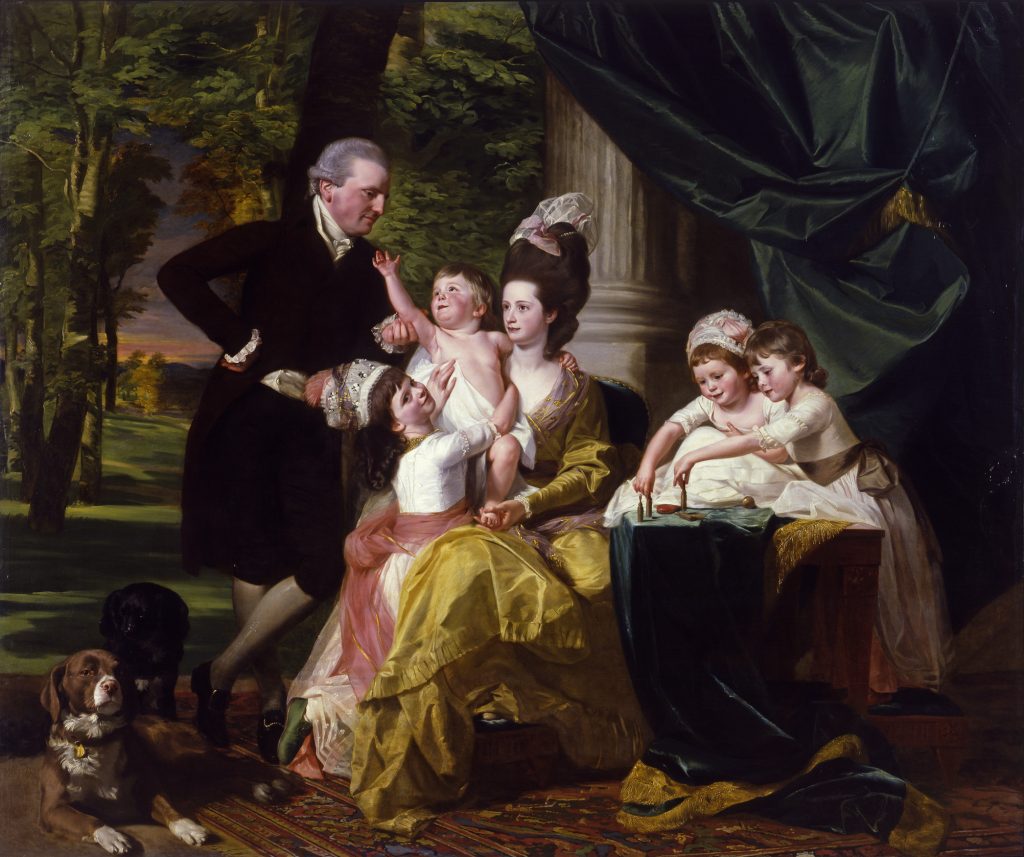John Singleton Copley (artist)
John Singleton Copley started out painting portraits of wealthy people in...
view artistStudents will improve visualization skills through role play, texture identification, and creating an original work of art depicting their own families. They will also discuss connections between the painting and their own lives. These activities will help them engage with the work of art and better understand what the artist is communicating about the family being portrayed.

Sir William Pepperrell (1746-1816) and His Family, by John Singleton Copley
Day 1
1. Discuss the meaning of the term family today. What is a family? How is our class like a family? Ask students to bring a photograph of their family or those people who are important in their lives to school the next day.
2. Show students Copley’s painting of the Pepperrell family. Tell the students that the painting is a historical portrait of a family. Ask them to describe what they see.
a. Who are the people in the painting?
b. Where are they?
c. How are they dressed?
d. Do you think this was a real family? Why or why not?
e. How did the artist show the family?
f. Is this picture from now or long ago? How do you know? How might it look different if it were of a family today? Tomorrow, you will have a chance to make your own portrait of your family.
Day 2
1. Compare this portrait to the photographs that students brought from home. Have students share their experiences being photographed individually or as a family. Discuss the term portrait.
2. Set up three learning stations around the room. Provide an 8 1/2 x 11″ image of the painting and appropriate materials at each station. Students can rotate through the centers in small groups.
3. Come back together as a class. Show students an image of the painting. Ask them to discuss what it felt like to dress up and pose like the family in the picture. Have them describe what they think the figures in the painting may be thinking or wanting to tell us (the viewers). Ask questions like:If you could meet a member of the Pepperrell family, who would it be? Why?What is a question you would like to ask that person?
Compare the wall of student art with the Pepperrell family. Discuss:How is our work different from Mr. Copley’s work? (different materials, different subjects, long ago/now)How are they similar?How did the sensory station make you think about your art work and the Pepperrell family?
Day 3
1. As a class, create a diamond poem about the Pepperrell family. Have students dictate a list of 10–15 words that come to mind when they look at the family in the painting, answering the question, “How do you describe the Pepperrell family?” Have them select their best words and create a diamond poem using the following form:
One word
Two words
Three words
Two words
One word
2. Students in grades 1 and 2 can come together to brainstorm these words for a class list. You could give the students the poem model and ask them to write their own poem about the family using words from the list.
3. Post these poems, the “pose for the camera” photographs, and family portraits drawings next to an image of the Pepperrell family. Discuss similarities and differences. Students could write in journals about what they notice.
Written by Carolyn Walker, English Language Arts Teacher
● Use class discussion, anecdotal records, and the drawing activity to determine students’ ability to make connections between their own lives and the family represented in the painting.
● Evaluate original art for students’ understanding of depicting ideas about people and portraits, using real sources of inspiration.
● Through discussion, evaluate how students recognize subjects, symbols, and themes in the works of others and how students compare the focus work with their own art and classmates’ art to show how artists express ideas differently in the past and present.
● Evaluate discussion using local rubrics for student participation, including following rules for discussion, building upon others’ ideas, and asking questions.
● Evaluate the poem using local rubrics for participating in shared writing and recalling information.
● Use the role play to assess the students’ ability to assume a role and to recognize the role of costume, props, and setting to communicate meaning. Through discussion evaluate students’ understanding of the way they communicated nonverbally through costumes and posing for the pictures.
Vocabulary
portrait
Materials
Touch bag items (satin/silk, fur, marble, leaf/tree bark, wool)
Role-playing costumes (dresses, sashes, hats, man’s suit) and props (toy dogs, drapery, tree, table, game, carpet, baby doll)
Disposable, Polaroid, or digital camera
Drawing materials (white paper, colored pencils, markers, or crayons)
Diamante worksheet
Links
John Singleton Copley started out painting portraits of wealthy people in...
view artist